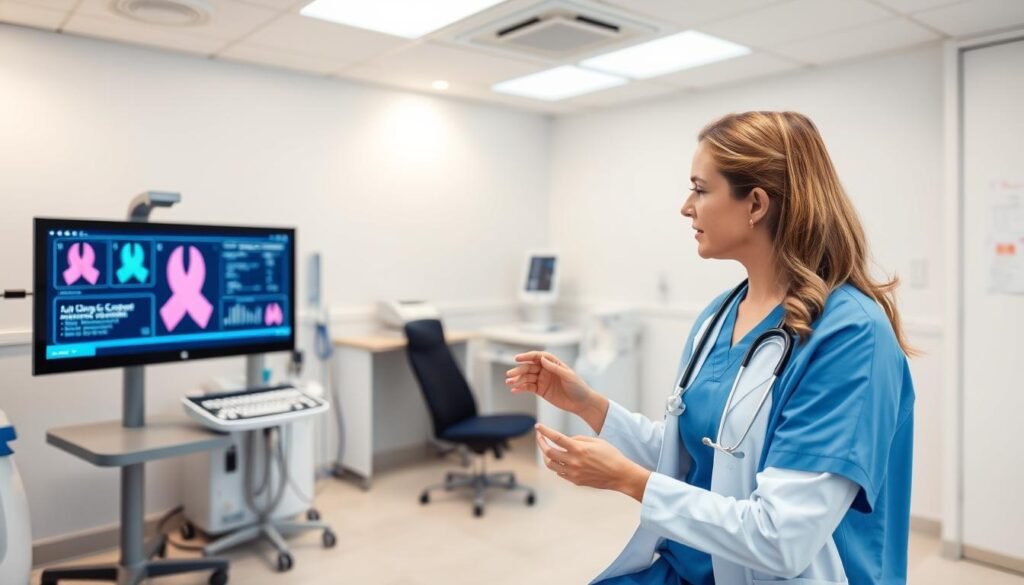Did you know that smoking is linked to up to 90% of lung cancer cases? This fact shows how important it is to predict someone’s risk individually. Now, we are getting better at tailoring lung cancer detection to fit each person’s health. This method is more effective in finding lung cancer early, aiming to cut down death rates from the disease.
Personalized risk assessments for lung cancer look at many things. They consider age, gender, smoking history, and other health details to find those at high risk. By focusing on each person’s specific risks, doctors can offer the right kind of help early. This greatly improves the chance of beating lung cancer. Today, we delve into how these assessments make lung cancer screening better. We see how they help both patients and doctors make informed decisions.
Key Takeaways
- Personalized assessments enhance the accuracy of lung cancer predictions.
- Early detection strategies significantly reduce mortality rates.
- Individualized approaches lead to more effective screening programs.
- Incorporating diverse risk factors results in better identification of high-risk individuals.
- Healthcare providers play a crucial role in implementing these risk assessments.
Introduction to Lung Cancer
Lung cancer is a top cause of cancer deaths worldwide, with 1.8 million people diagnosed each year. About 1.6 million people die from it annually. With a five-year survival rate at only 13.8%, early detection is crucial.
It was responsible for 20% of all cancer deaths in Italy in 2018. That year, lung cancer ranked as the third most common cancer, making up 11% of all cancers there. Shockingly, 85% to 90% of cases are linked to smoking. Quitting smoking can significantly reduce lung cancer risk a decade later.
About 75% of lung cancer cases are found at late stages. This makes treatment difficult. Screening often uses age and smoking history, missing personal risk factors.
Researchers are now using machine learning to improve screening. One example is low-dose computed tomography (LDCT). It has been shown to decrease lung cancer deaths by 20% in high-risk groups compared to X-rays. Early detection is key to better outcomes. Learn more about lung cancer detection efforts here.
Understanding Lung Cancer Risk Factors
It’s crucial to know the many causes of lung cancer for good risk checks. Things like smoking, the environment, and genes can raise the chances of getting this serious disease. Each factor plays a key role.
Smoking History Analysis
Smoking is the biggest cause of lung cancer, making up 75-90% of cases. A detailed look at someone’s smoking history helps give a clearer risk picture. It looks at how long they’ve smoked, how much, and quitting attempts. This info lets health pros give better advice specific to the person.
Environmental Exposure Factors
Where you are can affect your lung cancer risk too. Polluted air and certain jobs expose you to bad stuff, raising cancer risks. Scientists are looking at how these outside factors work with personal ones. This helps make tests and advice more targeted.
Genetic Biomarkers
Nowadays, gene research is finding markers that show who might get lung cancer. These markers lead to screenings and care that’s just right for the person. Doctors can use this info for better lung cancer fighting plans.
The Importance of Early Detection Strategies
Lung cancer is the top cause of cancer deaths worldwide. In 2020, it led to 1.8 million deaths. Early detection is key to improving these numbers, especially for non-small cell lung cancer (NSCLC). This type makes up about 85% of lung cancer cases.
Screening with low-dose computed tomography (CT) can greatly improve survival rates. Research shows a 20% drop in death rates from lung cancer with LDCT screening. The NLST and NELSON trials also show how effective early detection can be. They report fewer lung cancer deaths with these methods.
The 5-year survival rate for lung cancer is only 19%. But, it jumps to over 75% when found early. Still, only 21% of lung cancers are discovered early. Thus, we need better early detection, especially for people at high risk. Groups like NCCN and USPSTF have set guidelines for these people.
- Early detection can greatly lower death rates.
- Screening needs to be personalized based on individual risk.
- More awareness and education can help catch lung cancer early.
Even with the benefits, there are big hurdles. Cost and insurance issues often stop people from getting screened. We must overcome these barriers. This way, lung cancer screening can be available to everyone. This is crucial, no matter their situation or risk level.
Personalized Lung Cancer Screening
Personalized lung cancer screening is changing how we spot those at risk. Now, doctors pick who to screen by looking deeply into their risk factors. This means not everyone is treated the same way. The goal is to make sure the right people get checked early on.
Recent studies show this new way of screening is effective. By using blood tests along with other screening tools, results got better. The accuracy of finding lung cancer improved, which is great news. This helps avoid unnecessary tests and worry for patients.
These special programs could find 9.2% more lung cancer cases. They could also cut down on false alarms by 13.7%. This is based on a study of over 10,000 samples. Such personalized screening could change many lives for the better.
It’s key to match screening to what people want. Sites like ShouldIScreen.com offer tailored risk checks. This helps people decide if screening is right for them. Those with a slightly higher risk get the most benefit from customized advice.
Doctors are working hard to improve lung cancer screening. The goal is to respect what patients prefer. This new approach aims to make care better suited to each person. It’s a big step forward in fighting lung cancer.
Advantages of Personalized Lung Cancer Risk Assessments
Personalized lung cancer risk assessments offer major wins in screening. They focus on individual risk factors for better health care plans.
Improved Predictive Accuracy
An improved predictive accuracy is a big plus. By using personal risk factors, these assessments better pinpoint who’s at risk. Early detection methods work better this way, helping those who need it most.
Reduction in False Positives
Reducing false positives is another key advantage. Personalized checks lower the risk of wrong diagnoses. This eases patient worry and saves on unnecessary tests. It makes lung cancer screening more effective and efficient.
Precision Medicine Approach in Lung Cancer
Precision medicine transforms how we treat lung cancer by focusing on each patient’s unique features. These include their genetic make-up. This method gives us a clearer picture of the disease’s risk and outcome. It also helps predict how well treatments will work. Healthcare professionals use specific biomarkers to craft personalized treatment plans for lung cancer patients.
Recently, countries like the United States, the United Kingdom, Denmark, and Germany have made strides in precision medicine. The Precision Medicine Initiative, started in the U.S. in 2015, shows a strong push toward using clinical data and biomarkers to improve health.
Treatment methods vary greatly for patients with certain genetic markers in their lung cancer. For example, treatments for lung cancer with EGFR-positive markers differ from those without. This difference shows how crucial biomarkers are in deciding on treatment. Precision medicine uses information from our genes, proteins, and more to customize care.
Immunotherapy drugs have made big leaps in lung cancer treatment by targeting specific tumor markers, like PD-L1. Seeing different responses in patients based on their PD-L1 status shows the power of personalized treatments.
Also, new technologies like liquid biopsy are changing the game. They use things like circulating tumor cells (CTCs) for a less invasive way to look at lung cancer. This method helps doctors track the cancer more accurately and adjust treatments as needed.

Risk Stratification Models: Tailoring Screening Programs
Risk stratification models are vital in lung cancer screening. They help health providers find people at high risk. Using these models makes screenings more efficient. It ensures that high-risk individuals get the focus they need.
Identification of High-Risk Individuals
Risk stratification models sharply identify those at high risk. This helps to get more people screened. Sadly, only 5-15% of eligible people actually get screened. Providers can focus on those most likely to benefit by looking at risk factors. This includes smoking history and family cancer history. This focus improves screening efficiency and saves money.
Personalized risk assessments are often better than traditional methods. They can catch lung cancer early. For more details, check this source.
Guiding Treatment Decisions
Understanding individual risk profiles is key to effective treatment. Personalized risk assessments help doctors plan the right treatment. This approach matches the patient’s risk and the cancer’s specifics. Biomarkers also play a big role in planning treatment.
Many experts are pushing for better lung cancer screening and treatment plans. These personalized methods could greatly improve how patients fare.
| Factors Influencing Lung Cancer Screening | Percentage of Respondents |
|---|---|
| Would use biomarkers to guide eligibility | 58% |
| Concerned about time availability for personalized screenings | 66% |
| Interested in adopting personalized screening programs | 50% |
| Regularly assess screening eligibility | 84% |
| Less likely to assess lung cancer screening eligibility (NPs and PAs) | Compared to physicians |
Challenges in Implementing Personalized Assessments
The move towards personalized assessments, especially for lung cancer risk, faces Implementation Challenges. It’s hard to set up data systems that are both fast and accurate. If the data isn’t thorough, figuring out someone’s risk correctly is tough.
Training healthcare workers is critical. They need to know how to use new tools well. Without the right training, the full advantages of personalized assessments might be missed. Also, making sure everyone has access to these tools is important. We must ensure that people from all backgrounds can get these assessments.
Identifying who is at high risk accurately is a big hurdle. If the algorithms aren’t good, some patients might be wrongly tagged, messing up the screening results. We must keep checking and improving our screening methods to avoid these problems.
To illustrate some of the key challenges, consider the following table:
| Challenge | Description |
|---|---|
| Data Collection | Need for robust data systems capturing relevant health information. |
| Provider Training | Healthcare professionals require training to implement new assessment tools. |
| Equitable Access | Diverse populations need equal access to risk assessment services. |
| Bias and Identification | Concerns about potential biases in identifying high-risk patients. |
| Protocol Refinement | Ongoing evaluation needed to adjust screening protocols effectively. |

Targeted Prevention Strategies Derived from Risk Assessments
Healthcare pros can create better strategies by knowing each person’s risk. Targeted prevention boosts the success of stopping cancer. It uses personal details to design special efforts for everyone’s needs.
Developing Tailored Interventions
Custom plans are key to better health results. They can mix lifestyle changes, stop smoking programs, and check the environment. This mix is a strong way to prevent lung cancer.
Plans may target those at high risk, like heavy smokers or those whose families had lung cancer. A study with 19,146 heavy smokers showed targeted screenings can save lives and resources. It showed the value of custom methods in lung cancer checks.
Custom plans do more than fight lung cancer risks. They fit with bigger goals to cut cancer deaths. Using risk assessments is crucial for personalized care that boosts health for all.
The Role of Healthcare Providers in Personalized Assessments
Healthcare providers are key to the success of personalized lung cancer risk assessments. They help patients grasp the importance and benefits. It’s noted that 84% regularly check for lung cancer screening eligibility in their work. This underlines the need for proper training and support for these professionals.
However, there are hurdles. About 66% worry they lack time for personalized screening. This points out the importance of making the process quicker and easier. Efficient tools are needed to keep the care quality high.
Prediction models for risk are showing promise for better screening. 58% of providers are open to using biomarkers to judge if someone is eligible. This shows how informed decisions can lead to better patient care.
The latest guidance from the US Preventive Services Task Force has made screening guidelines more thorough. It’s vital for healthcare providers to keep learning about these updates. This encourages ongoing learning and adapting.
Healthcare workers need to make sure high-risk groups get to these personalized assessments. Data shows differences in screening rates among various healthcare roles. Teamwork across specialties can help reach more people who need screening.

| Role of Healthcare Providers | Survey Findings |
|---|---|
| Regular Assessment of Lung Cancer Screening Eligibility | 84% of providers do this |
| Interest in Personalized Lung Cancer Screening | 50% of respondents expressed interest |
| Concerns About Time Availability | 66% voiced concerns |
| Willingness to Use Biomarkers | 58% would use them for eligibility assessment |
Conclusion
Personalized lung cancer risk assessments are a big step forward in fighting cancer. They help us understand each person’s risk better. This leads to finding and treating lung cancer more effectively. By focusing on each person, we can greatly reduce the chance of mistakes, making patients’ experiences and outcomes better.
Studies, like the National Lung Cancer Screening Trial, show that yearly low-dose CT scans help save lives in people at high risk. The future looks bright for these risk assessments. But, we need to work on getting everyone on board with this approach. It’s essential to give people the right information about their screening choices.
Using these personalized methods can not only lower death rates but also improve patients’ lives. It’s about making sure doctors and patients talk well with each other. This way, we can make the most of these risk assessments. And we can start a new chapter in preventing and managing lung cancer.